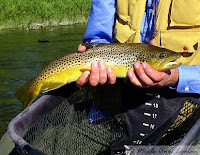
Brown trout from the Bitterroot in the spring
Fall brings cooler temperatures that cue brilliant foliage, migrating geese and spawning brown trout.
Brown Trout (Salmo trutta) is an exotic species in Montana. It was introduced to North America and Montana in the late 1800’s. Brown trout belong to a different genus than our native trout species. Widely stocked early in this century, they are currently doing well as a self-sustaining population.
The brown trout are golden brown with spots, lots of spots. They have black spots that may be irregular, and often red and orange spots. A distinct characteristic is spots with halos on the gill covers. Their tails are short and square. They commonly grow to 12 to 20 inches, but Montana’s state record is 29 pounds.
Brown trout feed largely on underwater aquatic insects. And, as a predaceous fish, more so than rainbow or cutthroat, the larger browns often feed at night on other fish, crayfish and other invertebrates. Brown trout have a few advantages over native Montana trout species. Brown trout are better adapted to disturbed habitats, and can live in areas that experience unnatural changes in water level, temperature, and water quality.

Brown trout caught by Jeff
Brown trout also lay their eggs in the fall, getting a jump on the native species which spawn in the spring making them subject to irrigation seasons water fluctuations among other things. Spawning occurs for brown trout when water temperatures drop to about 40 degrees F. and lasts usually from October through December in Montana. Female brown trout make redds in gravel or small pebbles in shallow water, usually less than a foot deep. Females deposit the eggs, males fertilize the eggs and they are covered with very small gravel or silt. In the spring, about 50 days later and at 50 degrees F, the surviving eggs hatch.
Some brown trout spawn on their resident rivers, but to find the right (very specific) conditions most migrate, sometimes traveling great distances upriver or into tributaries. During this critical time for brown trout, if you are aware of spawning beds where you are fishing, it is preferable not to disturb them.
Here are some things to think about when fishing during the spawning period:
- Stay away from the redds, do not walk in them. In general, they will be in clean gravel and it will look like someone dug a hole in the smaller gravel.
- Fish downstream to the probable pods of trout below the redd, not IN the redd. A clue is fish sitting on top of thecleared off gravel in pairs.
- If you catch a spawning trout, try not to sap their strength; play them quickly, release them quickly and of course, handle them gently.
- Last, target fewer fish. Catch a few, and then move on to another area.
Brown trout are usually in the larger, slower and lower gradient streams often where there are logs and other structure available to hide under. They also do well in reservoirs.
Brown trout are a popular game fish and a challenge to catch because they are selective and wary. When an angler catches them, it is exciting as they can be large and put up a good fight, running with the line.
Montana University System Water Center – Brown trout information
Utah on the Fly Article – The Bedroom of the Browns: Acting Responsibly During the Spawning Season, by Jim McGeever
Merle’s SmugMug photo site – Many more brown trout photos in their original format
great post and good info. those browns have some great colors.
ReplyDeleteA good size trout. I love fishing too but have to put my hobby on hold first due to work and children commitment! LOL!
ReplyDelete